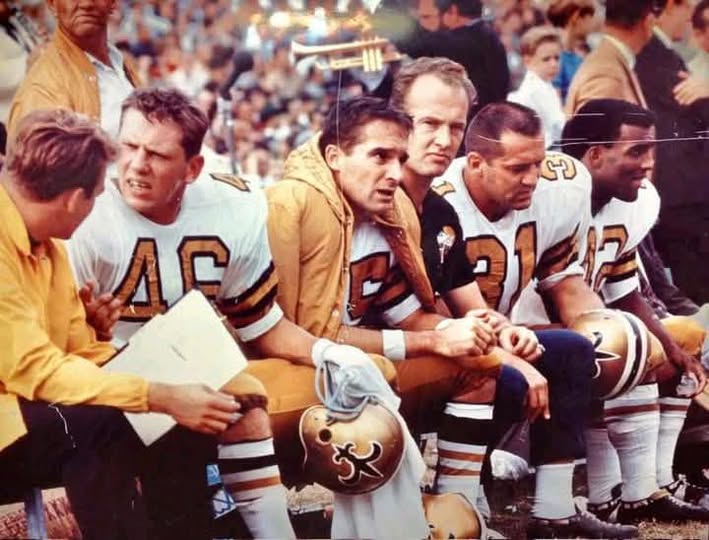LET’S TALK HISTORY❣️: The Team That Sparked a Legacy and Brought NFL Football to Louisiana
Today, as fans fill the seats of Caesars Superdome in a sea of black and gold, the echoing chants of “Who Dat” serve as more than just a cheer — they are the heartbeat of a state, the rallying cry of a culture, and the legacy of a franchise born from vision, perseverance, and pride. It’s easy to get lost in the excitement of game day — the roar of the crowd, the pulse of the music, the unmistakable rhythm of New Orleans. But to truly appreciate what NFL football means to Louisiana, we need to journey back in time to where it all began — to the team that sparked it all.
In the 1960s, professional football was growing rapidly across the United States, and the National Football League was looking to expand. Louisiana, with its rich sports traditions and fiercely loyal fan base, was an untapped market with enormous potential. But it wasn’t just potential that brought the NFL to New Orleans — it was persistence, politics, and the power of timing.
It all started with a group of civic leaders and businessmen who believed that New Orleans could be more than just a college football town. In the early 1960s, local officials, including U.S. Congressman Hale Boggs and Senator Russell Long, began lobbying heavily for an NFL team. It was a long shot at first. The city didn’t yet have a stadium that met NFL standards, and there was skepticism about whether professional football could thrive in the Deep South, where college football reigned supreme.
But momentum began to build. The 1965 AFL All-Star game was scheduled to be held in New Orleans but was moved after Black players boycotted due to rampant racism and discrimination they faced in the city. It was a public relations disaster for New Orleans, but it lit a fire under local leaders to make meaningful change and prove that the city could support a professional sports team in an inclusive and sustainable way.
Everything changed on November 1, 1966 — All Saints Day. NFL Commissioner Pete Rozelle officially awarded the 16th franchise to New Orleans. It was a moment of triumph, a culmination of years of lobbying and negotiation. The team was fittingly named the New Orleans Saints, a nod both to the jazz standard “When the Saints Go Marching In” and the city’s Catholic heritage. The symbolism wasn’t lost on anyone. Football, in many ways, became a kind of religion in Louisiana, and the Saints were its newly anointed prophets.
The team played its inaugural season in 1967 at Tulane Stadium. On the very first play of their very first regular-season game, Saints receiver John Gilliam returned the opening kickoff 94 yards for a touchdown. The stadium erupted. The city, long hungry for the national spotlight in sports, had its first magical moment. Though the Saints would go on to lose that game — and many more in those early years — a bond had been forged between team and town that would only grow stronger with time.
For much of their early history, the Saints struggled. The team endured 20 straight seasons without a playoff appearance. Fans suffered through painful losses and forgettable seasons, but their loyalty never wavered. In fact, the passion of Saints fans became legendary. They coined the term “Who Dat” — short for “Who dat say dey gonna beat dem Saints?” — and it became a badge of honor. Even when the team was losing, fans packed the stadium, wore paper bags over their heads as “The Aints,” and kept the faith.
Then, in 1987, the tide finally turned. Under head coach Jim Mora, the Saints finished the season 12–3 and made their first-ever playoff appearance. The wait had been long — two decades — but the reward was sweet. It was proof that perseverance pays off. Though the team lost in the first round, it didn’t matter. The Saints had arrived.
In the years that followed, the Saints continued to build a competitive team, but it wasn’t until the arrival of head coach Sean Payton and quarterback Drew Brees in 2006 that the franchise truly found its golden era. Their arrival coincided with the city’s recovery from one of the darkest chapters in its history — Hurricane Katrina.
The Superdome, which had once symbolized the city’s ambition, had become a symbol of tragedy in 2005 as thousands sought shelter there during the storm. Many wondered if the city would ever fully recover — and whether the Saints would remain. But when the team returned to New Orleans in 2006, they became a beacon of hope. The reopening of the Superdome for the home opener that year was one of the most emotional nights in sports history. Steve Gleason’s blocked punt against the Falcons is forever etched in Saints folklore — a moment of redemption, resilience, and rebirth.
That momentum carried into the next few years and culminated in the Saints’ crowning achievement — winning Super Bowl XLIV on February 7, 2010. Brees was named Super Bowl MVP, and the team defeated the Indianapolis Colts 31–17. It was more than just a victory on the field — it was a spiritual triumph for an entire state still rebuilding from disaster. The Saints weren’t just champions of the NFL; they were heroes of Louisiana.
Since that magical season, the Saints have remained one of the most competitive and respected franchises in the league. They’ve had playoff runs, heartbreaks, and transitions — including the retirement of Brees in 2021 and Payton stepping down in 2022. Yet through it all, the culture of the team has remained the same: resilient, passionate, and deeply tied to its community.
And now, today, as fans pour into Caesars Superdome — no longer just a stadium but a cultural landmark — they carry that history with them. They wear jerseys not just of current stars but of legends who paved the way. They bring their children and grandchildren, sharing stories of watching the Saints long before they were champions. They chant “Who Dat” not out of routine, but out of pride — because they remember when nobody believed in New Orleans football, and they remember how far the franchise has come.
NFL football in Louisiana isn’t just a game. It’s a cultural institution, a source of unity in a state known for its diversity, a reminder of how sports can bring people together even in the hardest of times. From Tulane Stadium to the Superdome, from losing seasons to Lombardi Trophies, the journey of the Saints is the journey of a city — and a testament to what’s possible when belief meets resilience.
So, the next time you find yourself in the heart of New Orleans on a Sunday afternoon, surrounded by tailgating fans and the rhythm of brass bands echoing through the streets, take a moment to appreciate the history. Take a moment to think about that first kickoff in 1967, that Super Bowl night in Miami, and every win, loss, and memory in between. Because this isn’t just football. This is legacy. This is culture. This is Louisiana. And these are your New Orleans Saints.



